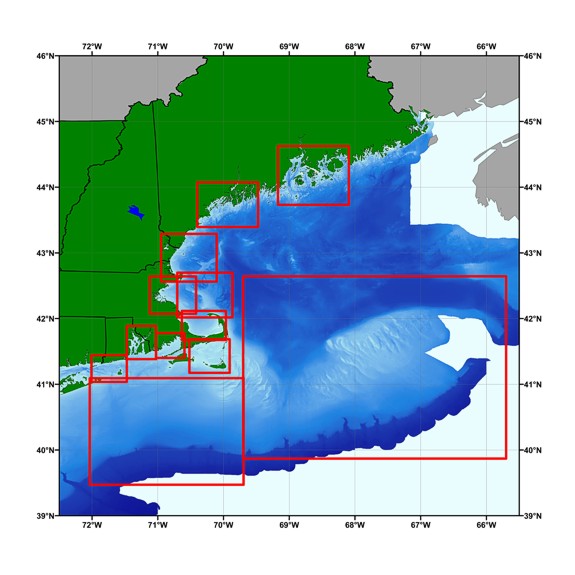

  |
VISUALIZING THE TEXTURAL DATAAlthough also provided in ASCII (.txt) and Microsoft Excel (.xls) formats, the data available on this report are supplied in
Environmental Systems Research Institute, Inc. (ESRI), shapefile format to be viewed and processed with a Geographic Information
System (GIS) application (e.g. ArcView, ArcExplorer, MapInfo). Users without a GIS application
Color coding is used to illustrate the surficial sediment distribution documented by the point coverages. Samples for which full grain-size data are available were assigned classifications based on definitions found in Shepard (1954). Classification was approximated for those samples for which only lithologic descriptions or partial data are available. In displaying the textural descriptors, the general ranking principle of the main constituents (e.g. gravel, sand) and modifying constituents (e.g. sandy, silty) follows in order of decreasing coarseness from warmer to cooler colors. Specifically, the color display follows this pattern:
SEDIMENT DISTRIBUTION MAPSTo access PREVIEW images showing sample locations and the distribution of surficial sediments from selected areas off the northeastern U.S., click within the desired box from the map below. A PREVIEW image in GIF format will be displayed in a new browser window. A larger PREVIEW image in JPEG format may be selected from the new browser window. The PREVIEW images may also be found by browsing the /maps directory located at the top level of this report. The user may select to view the maps with a system program and may be opened in an appropriate graphics application (such as Corel Draw or Adobe Illustrator). Instructions for downloading the full-resolution maps may be found by going here.  Index map of available detailed images showing the Images showing the distribution of surficial sediments from selected areas can also be viewed through the table below. The sediment textural classification color scheme is as described above. Selecting an image map from the GEOGRAPHIC AREA column will display a small preview image in GIF format in a new browser window. A larger PREVIEW image in JPEG format may be selected from the new browser window. All PREVIEW images have been reduced for optimum viewing with a web browser. Because the PREVIEW images have been reduced to a standard length of 1250 pixels, please note that the images will not be of the same scale.
Downloading a selected file with Microsoft Internet Explorer To download a data file while using Microsoft Internet Explorer, the user should select the desired file by placing the system pointer on the file name from the data list and pressing the right mouse button. This will display a pull-down menu from which the user should drag the mouse to highlight "Save target as ..." and release the mouse button. Internet explorer will then prompt the user to specify the name and location of where the selected data file should be saved. Downloading a selected file with Netscape To download a data file while using the Netscape browser, the user should select the desired file by placing the system pointer on the file name from the data list and pressing and holding the right mouse button. This will display a pull-down menu from Netscape. The user should drag the mouse to highlight "Save this link as ..." and release the mouse button. Netscape will then prompt the user to specify the name and location of where the selected data file should be saved. Different operating systems and newer versions of Netscape might work somewhat differently. |
